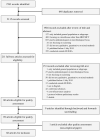A systematic review of barriers and facilitators for hepatitis B and C screening among migrants in the EU/EEA region
- PMID: 36875381
- PMCID: PMC9975596
- DOI: 10.3389/fpubh.2023.1118227
A systematic review of barriers and facilitators for hepatitis B and C screening among migrants in the EU/EEA region
Abstract
Introduction: Hepatitis B and C are a threat to public health. Screening of high-risk groups, such as migrants from high-endemic areas, enables early identification and treatment initiation. This systematic review identified barriers and facilitators for hepatitis B and C screening among migrants in the European Union/European Economic Area (EU/EEA).
Methods: Following PRISMA guidelines, databases PubMed, Embase via Ovid, and Cochrane were searched for English articles published between 1 July 2015 and 24 February 2022. Articles were included, not restricted to a specific study design, if they elaborated on HBV or HCV screening in migrant populations from countries outside Western Europe, North America, and Oceania, and residing in EU/EEA countries. Excluded were studies with solely an epidemiological or microbiological focus, including only general populations or non-migrant subgroups, or conducted outside the EU/EEA, without qualitative, quantitative, or mixed methods. Data appraisal, extraction, and quality assessment were conducted and assessed by two reviewers. Barriers and facilitators were categorized into seven levels based on multiple theoretical frameworks and included factors related to guidelines, the individual health professional, the migrant and community, interaction, the organization and economics, the political and legal level, and innovations.
Results: The search strategy yielded 2,115 unique articles of which 68 were included. Major identified barriers and facilitators to the success of screening related to the migrant (knowledge and awareness) and community level (culture, religion, support) and the organizational and economic level (capacity, resources, coordinated structures). Given possible language barriers, language support and migrant sensitivity are indispensable for facilitating interaction. Rapid point-of-care-testing is a promising strategy to lower screening barriers.
Discussion: The inclusion of multiple study designs provided extensive insight into barriers, strategies to lower these barriers, and facilitators to maximize the success of screening. A great variety of factors were revealed on multiple levels, therefore there is no one-size-fits-all approach for screening, and initiatives should be adopted for the targeted group(s), including tailoring to cultural and religious beliefs. We provide a checklist of facilitators and barriers to inform adapted interventions to allow for optimal screening impact.
Keywords: facilitators and barriers; hepatitis B; hepatitis C; migrants; screening; systematic review.
Copyright © 2023 Moonen, den Heijer, Dukers-Muijrers, van Dreumel, Steins and Hoebe.
Conflict of interest statement
The authors declare that the research was conducted in the absence of any commercial or financial relationships that could be construed as a potential conflict of interest.
References
-
- World Health Organization . Global Progress Report on HIV, Viral Hepatitis and Sexually Transmitted Infections, 2021. Accountability for the Global Health Sector Strategies 2016–2021: Actions for Impact. Report. Geneva: World Health Organization; (2021). Report No.: 9240030999.
-
- World Health Organization . Hepatitis B in the WHO European Region. Factsheet. Geneva: World Health Organization; (2021).
-
- World Health Organization . Hepatitis C in the WHO European Region. Factsheet. Geneva: World Health Organization; (2021).
-
- World Health Organization . Combating Hepatitis B and C to Reach Elimination by 2030: Advocacy Brief. Geneva: World Health Organization; (2016).
Publication types
MeSH terms
LinkOut - more resources
Full Text Sources
Medical


